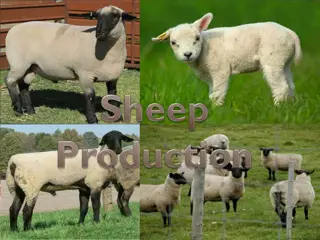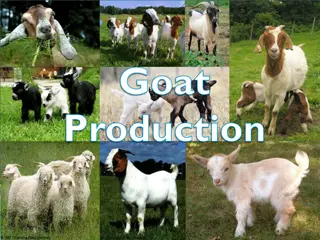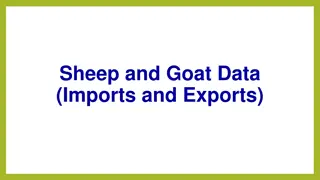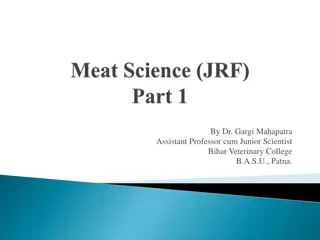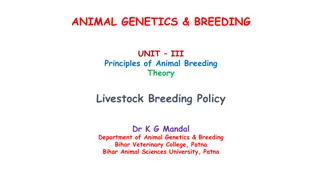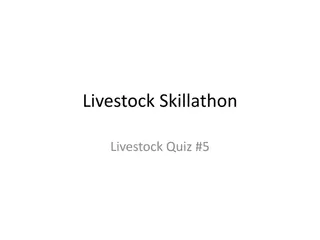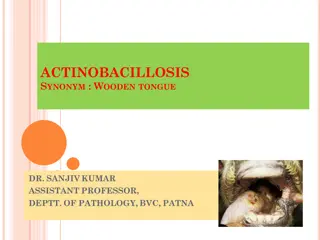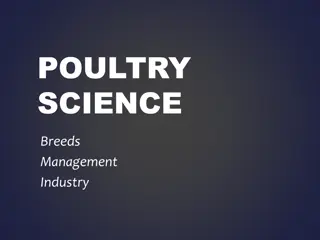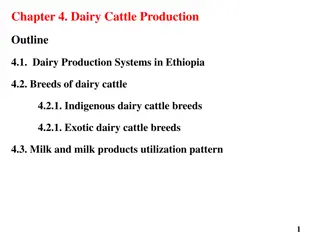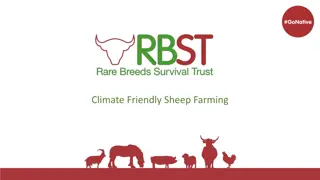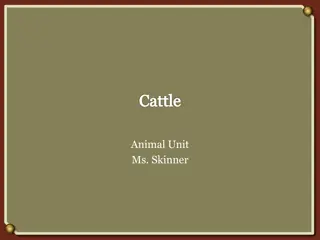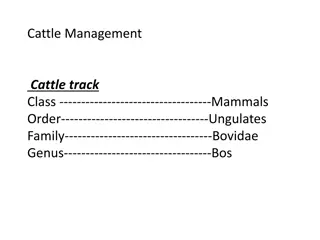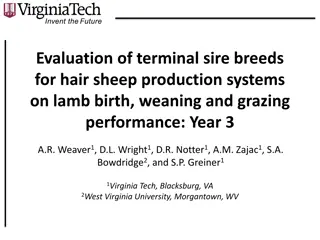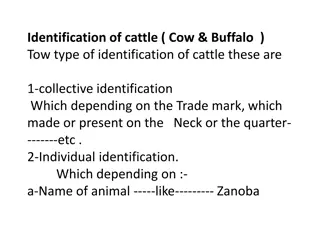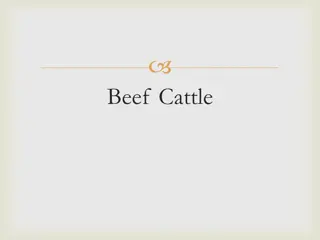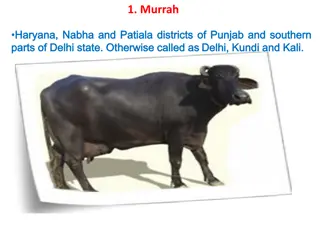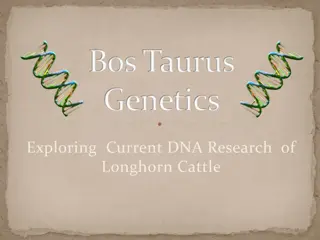Overview of Livestock Production: Cattle, Sheep, and Goat Breeds
Explore the diverse world of livestock production, including cattle ranching, dairy farming, hog and pig farming, poultry and egg production, and animal aquaculture. Delve into the specifics of sheep and goat production, from breeds and production systems to management practices, breeding techniques, and the importance of these animals in farming. Discover different breeds like Merino, Rambouillet, Columbia, Hampshire, Southdown, Suffolk, Angora, Boer, and Spanish goats, each with unique characteristics suited for wool, meat, or milk production.
Download Presentation

Please find below an Image/Link to download the presentation.
The content on the website is provided AS IS for your information and personal use only. It may not be sold, licensed, or shared on other websites without obtaining consent from the author.If you encounter any issues during the download, it is possible that the publisher has removed the file from their server.
You are allowed to download the files provided on this website for personal or commercial use, subject to the condition that they are used lawfully. All files are the property of their respective owners.
The content on the website is provided AS IS for your information and personal use only. It may not be sold, licensed, or shared on other websites without obtaining consent from the author.
E N D
Presentation Transcript
Livestock Production Cattle ranching and farming Dairy farming Hog and pig farming Sheep and goat farming Poultry and egg production Animal aquaculture
Sheep and Goat Production Breeds Production systems Management practices Breeding sheep and goats Wool Diseases Importance of sheep and goat production
Sheep Breeds (wool) Merino Rambouillet Most dominant breed in the industry worldwide Very fine fleeces Hardy, long-lived sheep Typically smaller and slower-growing Larger and faster growing than Merino Dominant range ewe in Western U.S. and TX Developed by King Louis XVI
Sheep Breeds (crossbred wool breed) Columbia Cross breed between Lincoln rams and Rambouillet rams Largest of crossbred breeds Coarser wool than Rambouillets
Sheep Breeds (meat breeds) Hampshire Southdown Sired for rapid growth and muscularity One of the most popular sire breeds in commercial sheep production One of the oldest sheep breeds Produce meaty, lightweight carcasses Low maintenance breed
Sheep Breeds (meat breeds) Suffolk Very old breed used as a sire breed in commercial production Rapid growth Produce lean, muscular carcasses
Goat Breeds Goats can be bred for: Wool Meat Milk
Goat Breeds Angora Produces mohair (world s finest and most valuable hair) Sheared twice a year Produced by kid goats (hair gets coarser as they age) Managed primarily under range conditions
Goat Breeds Boer Hardy, fast growing goat produced for meat Good spring of rib, body length, and muscle tone
Goat Breeds Spanish Goat spanish goat is used interchangeably with meat goat Mixed breed origin Mostly kept for meat production High variability in appearance
Goat Breeds Nubian Most popular breed of registered dairy goat in the U.S. High butterfat, but does not produce as much milk as some other breeds Sometimes referred to as the Jersey of milk goats
Sheep Production Systems Intensive Management Systems Farm flock operations Lamb feedlot Extensive Management Systems Southwestern range operations Northwestern range operations
Farm-flock Operations Common in the Midwest Smaller in size part of a diversified farming operation Primarily concerned with lamb production Maternal lines for prolific and heavy milking are mated to sire lines for fast growing and muscular carcasses to maximize pounds of high quality market lambs
Lamb Feedlot Intensively managed system where lambs are concentrated in a small area and fed diets that vary from 30-90% concentrate (either corn or milo) All of the feed is harvested then brought directly to the lamb Colorado is the leading lamb state
Southwestern Range Operations Usually use fine-wool type ewes Sheep are adaptable to the environmental conditions Produce high quality fine-wool fleeces and fast growing lambs Major impact factors: Rainfall Predators Prices for lambs and wool
Northwestern Range Operations Greater abundance of feed than the Southwest Larger, coarser-fleeced ewes used Flocks produce a greater number of lambs per ewe Often graze federal lands managed by the Forest Service and Bureau of Land Management
Goat Production Systems Hair Production Angora (mohair) Cashmere Meat Production No grading system for meat goats, so there is great inconsistency in product Dairy Goat Production Very intensively managed system that mimics the dairy cattle industry
Common Management Practices Range vs. Shed Lambing/Kidding Docking & Castration Crutching/Facing Drenching/Spraying Predator control Herding
Range vs. Shed Lambing/Kidding Range Shed Ewes and nannies generally lamb/kid easily on the range without assistance Genetics and nutrition are priorities to make sure problems with dystocia are minimized Ewes and lambs/kids are brought into a barn and put in jugs until they are properly bonded More labor and expenses in facilities are required Allows for closer monitoring for health problems
Docking and Castration Docking and castration are best performed at the same time around 2-4 weeks of age Procedures are less stressful early in life Methods for each procedure: Castration Docking Knife Elastrator Burdizzo All-in-one castrator Knife Elastrator Emasculator Electric docker
Crutching and Facing Crutching is shearing of wool from the reproductive area and mammary system of ewes before parturition Keeps area free of dirt and fecal matter Facing is shearing of the wool from the facial area Prevents obstruction of vision
Drenching and Spraying Drenching and spraying are for the removal of internal and external parasites
Predator Control Sheep and goats have many predators Mountain lions Wolves Putting different animals in the same paddocks or pens can help protect the sheep or goat herd Great Pyrenees Donkeys Llamas
Herding Working dogs Border collies Australian shepherds
How do you age sheep and goats? Use their teeth! All lamb s teeth are small (baby teeth) Yearlings have two large incisors 2 year olds have two sets of large incisors 3 year olds have three sets of large incisors 4 year olds have a full mouth of large teeth
Breeding Sheep Characteristics that are bred: Skeletal correctness Frame Wide chest and ribcage Muscularity Fleece (density, fineness, uniformity of grade)
Fleece crimp examples Lamb Body Characteristic Areas
Wool Production 1. Shearing done in the spring and takes 2-3 minutes 2. Grading sorting wool according to fineness and length 3. Packaging each bale contains ~500 lbs 4. Storage bales are sampled and processed to determine wool yeild 5. Marketing 6. Manufacturing sorted and cleaned before being processed into yarn
Wool Evaluation Wools are classified based on three main factors: Yield Grade Staple length Other factors can also include: Uniformity Color
Diseases Disease Cause Symptoms Treatment Prevention Clostridium perfringens (bacteria) Tumors, convulsions, diarrhea, death Penicillin, fluids, vitamins, cortisone Vaccinating ewes before lambing Enterotoxemia Virus (transmittable to humans) Scabs around mouth, nostrils, eyes Vaccines Soremouth Clostridium tetani (bacteria) Stiffness in joints, lockjaw Vaccinating ewes before lambing Tetanus Bacteria Internal/external abscesses that contain greenish pus, weight loss, poor milk production Isolate infected animals, shear infected animals last Toxoid vaccine Caseous Lymphadenitis Slow growth, morbidity, death in some Alleviate stress at weaning/hauling Coccidiosis Harmonchus contortus (worm) Anemia, weakness, sudden death, bottle jaw Deworming, pasture rotation Internal Parasites Flies, lice, ticks Anemia, wool break, twitching, stomping, etc. Ivomec or Ectrin, organophosphates Extenal Parasites Prion protein? (Unclear) Itching, tremors, gait abnormalities, weight loss, prefer salt to fresh water none Avoid contact with infected animals all replacements should come from a scrapie- free source Scrapie
Importance of Sheep and Goat Production Provide valuable asset in addressing future food shortages High reproductive rate + ability to utilize otherwise unusable forage sources = valuable Complement to beef cattle: use different proportion of grass, forbes, and browse


